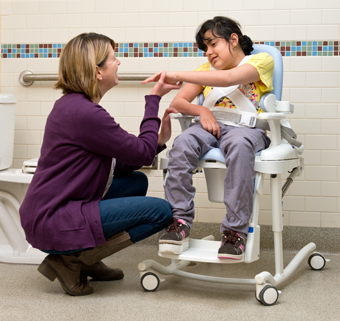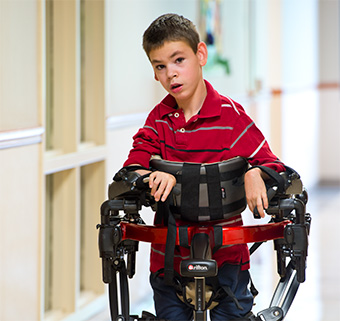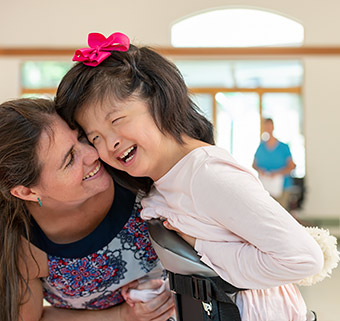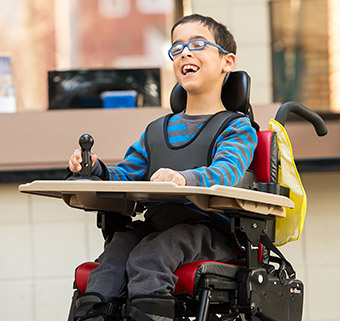MOVE: Hope for People with Significant Movement Disorders
| September 2011 By Stacie B. Whinnery, Ed.D., Associate Professor, University of West Florida and Keith W. Whinnery, Ph.D., Associate Professor, University of West Florida
By Stacie B. Whinnery, Ed.D., Associate Professor, University of West Florida and Keith W. Whinnery, Ph.D., Associate Professor, University of West Florida
Introduction
In the early 1980’s, Linda Bidabe, a special education teacher, was frustrated with the lack of progress in many of her students with severe multiple disabilities. Education, therapy theory, and practice at that time promoted programs based on an individual’s deficits. Professionals would identify what was wrong and then attempt to remediate deficits by teaching prerequisite (infant) skills designed to get individuals ready for functional, meaningful tasks. Additionally, each professional typically developed his or her own goals and interventions, which frequently led to disjointed, uncoordinated programming. Progress with this type of programming was poor. As a result, students often graduated from school programs lacking the skills needed for life beyond school.
In response to these shortcomings, Linda Bidabe proposed a pilot program to teach students to be upright and mobile in order to participate more fully in life activities important to the student and family. In 1986, eleven students participated in a seven-week pilot study in which educators and therapists worked together to achieve shared goals. For example, instead of a physical therapist taking a student to a separate room to develop posture and balance to get him ready for walking, everyone involved with the student was encouraged to work together to teach walking skills throughout the day in routine activities. Physical support was provided to enable a student to be in an upright position and take steps, and supports were faded as the student gained more skills. The incredible success of the students in the pilot study led to a demand for this special needs program in other classrooms in the county. As word spread about the students’ successes, Linda recognized that the program needed a name; Mobility Opportunities Via Education® was decided upon, and Linda was encouraged to write the MOVE Curriculum. Today MOVE International has spread across the United States, has been translated into 11 languages, and is being used in at least 26 countries.
The MOVE program is designed to enable individuals with physical disabilities to participate more fully in life by increasing their functional mobility skills in sitting, standing, walking, and transferring. The cornerstone of the MOVE curriculum is its philosophy and commitment to provide support for individuals and their families to reach their goals. This is accomplished through a team approach in which programs are constructed around the individual/family goals and integrated into the individual’s normal routines and environments. Watch an introduction to MOVE ™ International on Rifton’s YouTube channel.
A Story: Quinton
In 2002, Quinton was a 10-year-old student at Somerville Road Elementary in Decatur, Alabama, participating in traditional education and therapy programs. At that time, Quinton could only tolerate upright positions for very short intervals. Rachel Poovey, Quinton’s teacher, explained that his current therapy program, which was designed to follow the typical progression of motor skills, wasn’t working for him. Quinton’s health was poor, he was extremely overwhelmed by other people, he relied on others for full support during lifts and transfers, and his skills were deteriorating. Shortly after being introduced to MOVE, Poovey and the other members of Quinton’s educational team approached his parents about using the MOVE curriculum with him. After an initial assessment of Quinton’s current functional mobility skills and an interview to determine individual/family goals, programs were developed to teach Quinton to: a) sit in a regular chair for meals and class activities, b) stand to assist with dressing and toileting, and c) walk to preferred activities. Initially, Quinton could only partially participate in these activities and needed considerable support. However, two years later Quinton can sit in a regular chair with minimal support for classroom activities. He can participate in sit-to-stand transfers when moving around the classroom. He is also taking steps in a front-leaning walker to go where he wants to go. In addition, Quinton’s health has improved, and he now enjoys participating in school activities with his peers.
Community Access and Cost Savings
Although the primary focus of the MOVE Curriculum is the improvement of mobility skills needed to increase participation in functional activities, participants experience a number of secondary benefits. An important component of MOVE programming is the reduction of prompt supports. As individuals gain mobility they often rely less on bulky adaptive equipment, resulting in cost-savings and greater access to the community. Lamonte “Monte,” a student at James E. Duckworth School in Beltsville, Maryland, required a wheelchair and adapted walker prior to starting MOVE in September 2002. Monte was given numerous opportunities to practice walking skills (delivering items around the school, walking to other school activities, and walking to and from activities in the classroom). By October 2003, Monte took his first independent steps and by March 2004 he was walking independently on smooth surfaces. In May 2004, Monte walked up a ramp and across a platform with minimal assistance from a peer to light the Special Olympic Challenge Day flame. Monte’s mom, Carolyn Howell, stated that she is now able to take Monte shopping with his brothers without a wheelchair, a convenience she once thought impossible.
When Aaron first entered Leach School in Newcastle, Delaware, and began the MOVE program six years ago, he resisted upright positions in sitting and standing, preferring to lie on the floor. Aaron’s primary means of mobility was being transported in a stroller. In May 2000, Aaron began walking in the classroom with one or two hands held, and within a year he was able to walk for long distances while holding a grab bar on a walker. By the 2003 school year, Aaron was able to take several steps holding onto a ring that was also held by an adult to provide balance. Debbie Kiser, physical therapist at the Leach School, expressed, “our most exciting moments occurred this year when Aaron began to take independent steps in the pool…quickly followed by independent steps on land.” As his mobility skills improved, Aaron began to show more interest in the world around him. He began to express definite preferences for toys and activities, and he more willingly participated in classroom and self-care activities.
Health Benefits
Another important benefit related to MOVE is improved health. Within the MOVE curriculum, individuals are encouraged to be in upright, slightly forward-leaning positions as they develop active sitting and walking skills. These positions encourage active participation, provide opportunities for the development of trunk and head control, and result in improved health. Functional sitting (sitting with a forward lean of about 10 degrees) is encouraged for activities that require active participation, like eating, working at a table, playing, and using the computer. In addition to encouraging participation, this position eases the coordination of breathing and swallowing when eating, and facilitates coughing, thus improving respiratory health. Upright, weight-bearing and moving in an upright position improves bone health and bowel functioning.
Andres “Andy” started MOVE at the William Patrick Day Early Childhood Center in Cleveland, Ohio in September 2000 at two years of age. His first MOVE goals involved sitting on flat surfaces for baths and on the floor playing and walking from room to room at home and around the classroom. During the initial year, Andy was absent from school for 56 days for illness. With each extended absence, Andy lost strength and endurance and his body had to be reconditioned each time he returned to school. Despite these setbacks, Andy continued in the MOVE program and his mobility skills improved. His absences decreased to 13 days in 2002 and just 8 days in 2003. By the end of the 2003-2004 school year, Andy had accomplished his goal of sitting independently and he was walking over 300 feet using a front leaning walker (Rifton Pacer). This next school year, Andy will go to a regular kindergarten classroom.
When Breanna was three years old, doctors said she was at risk for hip dislocation and would need surgery. This was at the same time that her mom, Trellis Barnes, first learned about the MOVE® Curriculum. Working with two special education professors from the University of West Florida, Stacie and Keith Whinnery, Trellis began implementing MOVE at home with Breanna. After five months using MOVE, not only did Breanna develop her sitting, standing, and walking skills, but she also experienced a reduction in hip subluxation negating the need for surgery (for more information see Teaching Exceptional Children, 2002, Volume 34, No. 3).
 Increased Social Interactions
Increased Social Interactions
Participation in functional mobility activities ideally leads to the integration of relevant communication, cognitive, and social skill instruction. As individuals experience upright positions that allow them to learn about their environments, they often become better able to handle changes, become more interested in communicating their desires, and begin to interact more with those around them.
Tristan began the MOVE program in the fall of 1999 at the Children’s Center at UCP of Greater Suffolk in Commack, New York. Prior to starting MOVE, Tristan was unmotivated and very socially withdrawn from his peers. A front-leaning walker had been tried previously, but Tristan was disinterested and resisted using it. Sally Ayres, Adaptive Physical Education Teacher at the Children’s Center, explains that as programming began, the staff attempted to find practice opportunities throughout the day in activities that would be highly motivating to Tristan. As Tristan became interested in these activities, he began to develop the idea to get up and moving. Through committed team effort and family involvement, Tristan is now able to go out to dinner with his brother and parents, play with other kids during adapted physical education, race in his adapted walker at the New York State Games for the Physically Challenged, swim, and go horseback riding. Ayres commented that, “through the MOVE program…Tristan has become quite the social little boy – he will initiate conversations by walking over to his peers or adults.”
MOVE for Adults
Although MOVE was originally designed around the needs of school-age children with physical disabilities, it has been successfully adapted and used with toddlers and pre-school children. Success stories have also been reported from adult facilities where MOVE has been used on an informal basis with adults who have been immobile for many years. In fall 2003, a pilot study was initiated at Chesapeake Care Resources, Inc. (CCR) in North East, Maryland to develop a MOVE for Adults program.
Judy is a 50-year-old adult learner at CCR who is participating in the pilot study. From the age of nine and a half months until the age of 38, Judy lived in a state institution. Until Judy started in the MOVE program about two months ago, her primary mobility positions were in an expensive, specially molded wheelchair (costing $6104) due to scoliosis and kyphosis. Judy spent her entire day in her wheelchair, a reclining chair, or a bean bag. Because of her frail body and traditional programming, Judy never had the opportunity to sit in a regular chair or bear weight while standing.
After the initial training of the staff, a MOVE program was developed for Judy. Although she had limited skills in weight bearing and standing, practice opportunities were provided. Using her natural desire to be around people as motivation, Judy has been practicing her “sit to stand” skills to stand for hugs from staff and clear the table. Her direct support provider, Katie Donovan, also has Judy practicing her mobility skills by sitting in a regular chair for meals and standing in a Mobile Stander to take dishes to the kitchen afterwards. These naturally occurring activities will provide Judy the opportunities to continue to improve in these skills, and they will also provide the staff opportunities to introduce other related skills so that Judy can lead a more active, productive life.
Conclusion
MOVE is a relatively young program but has grown and has spread throughout the world because of success stories like the ones above. However, in order to help even more individuals and to be accepted in the professional community, there is a need for more formal research. Since the initial seven week pilot study by Linda Bidabe, a more formal program of research study on MOVE has begun. Several studies have been conducted and have shown the effectiveness of the MOVE program in increasing the functional mobility skills and participation in life of individuals with severe disabilities. [See Exceptional Children, Spring 2002, 68(3) and Teaching Exceptional Children, Spring 2002 34(3)]. For more information on MOVE® call 1(800)397-MOVE International or log onto www.move-international.org.
This article reprinted with permission from:
Exceptional Parent Magazine September 2004
EP Global Communications
551 Main Street
Johnstown, PA 15901
www.eparent.com
This article reprinted with the expressed consent and approval of Exceptional Parent, a monthly magazine for parents and families of children with disabilities and special health care needs. Subscription cost is $39.95 per year for 12 issues; Call (877) 372-7368.




